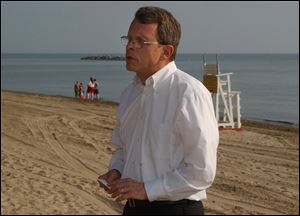
Lake Erie, other environmental issues factor into Ohio governor's race
9/9/2018
Gubernatorial candidates Mike DeWine, left, and Richard Cordray at the Ohio State Fair.
THE BLADE/KATIE RAUSCH
Buy This Image
One thing seems apparent as Ohio’s two gubernatorial candidates compete for the environmental vote: Republican Mike DeWine is not as predictable as his party label suggests.
While in the U.S. Senate, he angered fellow Republicans and then-President George W. Bush by repeatedly crossing party lines and voting against drilling in Alaska’s Arctic National Wildlife Refuge.
As Ohio’s attorney general, he testified at a 2014 hearing in Cleveland that the U.S. Army Corps of Engineers should immediately exercise the $18.4 billion option that had just been put on the table for keeping Asian carp out of Lake Michigan by going forward with a hydrologic separation of the Great Lakes and Mississippi River watersheds by rerouting the Chicago Area Waterway System that connects them.

Gubernatorial candidates Mike DeWine, left, and Richard Cordray at the Ohio State Fair.
That was never done, in large part because it is by far the most ambitious and costly proposal. But Mr. DeWine argued the projected length of time to do the work — 25 years — made such a pie-in-the-sky dream of many fish biologists viable.
He joined them and Democrats such as U.S. Rep. Marcy Kaptur of Toledo in fearing what would happen if Asian carp were allowed to wreak havoc on the Great Lakes region’s fishery, which is valued at $7 billion a year and supported heavily by western Lake Erie and Maumee River spawning.
RELATED CONTENT: Democratic candidate for lieutenant governor pushes for commission on women's issues ■ Ohio governor's race heats up as ads flood airwaves
TOM TROY: The bumbling bureaucrat versus the right-wing reactionary
He also joined several other states and municipalities this year in filing a multimillion dollar lawsuit against St. Louis-based Monsanto Co. that alleges it knowingly produced cancer-causing PCBs that put people’s health at risk long before the U.S. Environmental Protection Agency banned them in 1979. The case could have huge ramifications for Toledo’s Ottawa River and dozens of other PCB-laden waterways across Ohio, where millions of dollars have been spent on cleanup.
Democrat Richard Cordray, who served two years as Ohio attorney general and lost the position to Mr. DeWine in the 2010 election, isn’t at all persuaded by the argument that Mr. DeWine has shown a mixed bag of positions on the environment.
He said Mr. DeWine must shoulder part of the blame for Lake Erie’s situation — and that he, much like Gov. John Kasich, put too much faith in voluntary incentives aimed at getting more farmers to reduce algae-forming nutrient runoff from their fields.
“He does not have a strong environmental record,” Mr. Cordray said. “He's been AG for eight years. He can't say he had no role in this. He was the chief officer in the state. He's had his chance.”
Ask either gubernatorial candidate about Lake Erie, and they use words common to members of either party: It’s our crown jewel, our natural resource that must be protected.
Beyond that, though, it’s not always easy differentiating between the two.
Neither would answer specific questions about the landmark lawsuit before federal Judge James Carr, one in which the Environmental Law & Policy Center, on behalf of Advocates for a Clean Lake Erie, are seeking an order for the most aggressive cleanup strategy, called a Total Maximum Daily Load program.

Mike DeWine, then a United States Senator, speaks on the shores of Lake Erie at East Harbor State Park in Port Clinton in 2004.
Such a load program would put western Lake Erie on a “pollution diet” by capping the amount of phosphorus and other nutrients that could be allowed into it at given times, thereby putting the onus on large livestock operations and crop fields to cut back on the amount of manure and commercial fertilizer that is spread.
Mr. DeWine said he’s proud of what he did in the U.S. Senate for the Great Lakes and Lake Erie, especially on legislation aimed at enhancing wetlands that act as nature’s kidneys by filtering out contaminants and helping with flood control.
He’s still dumbfounded by Congress’ lack of movement on the Asian carp issue, not agreeing with Republicans who seem content to rely on an electrical barrier in the shipping channel. DNA research shows Asian carp may have eluded it at times.
“This electric barrier just is not going to work,” Mr. DeWine said.
As attorney general, he also has taken legal action against the Corps over its plan to dump silt dredged from the Cuyahoga River into the open water of Lake Erie, but had no explanation for why similar action hasn’t been taken in the Toledo area. The Toledo shipping channel, because of its shallowness, is by far the most heavily dredged in the Great Lakes region, with more silt dug from it than all other Ohio waterways along Lake Erie combined.
The silt from this area gets dumped into North Maumee Bay, a practice that has bothered fish biologists since it began in the mid 1980s. Governors and state environmental directors from both parties have tried to end the practice; two weeks before the 2014 Toledo water crisis, Mr. Kasich signed into law a bill that calls for a phaseout of that practice in 2020.
Ohio Sen. Randy Gardner (R., Bowling Green) was one of the architects of that bill, as well as ones calling for a statewide bond issue in which large sums of money would be borrowed to help protect Lake Erie.
The latest version, co-sponsored by Ohio Rep. Steve Arndt (R., Port Clinton) seeks approval for $500 million over five years to slow the flow of nutrients that help the lake’s algal blooms grow.
It is a scaled-back version of a $1 billion, 10-year plan proposed by Mr. Gardner three years ago that failed to win Gov. Kasich’s support.
“What I've come down to is: I think Randy Gardner's proposed bond issue makes a lot of sense. It would gain support of farmers and environmental groups,” Mr. DeWine said. “I think the most important thing I could do as governor is push the bond issue.”
Mr. Cordray did not address the bond issue during his interview. But he said we “obviously have a significant problem in western Lake Erie” and said he’s disappointed it took the Kasich administration so long to designate it as impaired. It did so last March under pressure from the U.S. EPA, because of the lawsuit before Judge Carr.
“It is as plain on the nose on anyone's face it is impaired,” Mr. Cordray said. “We need to move fast. We need to bring stakeholders together, including farmers who have felt left out. We need to find strong measures, not just voluntary measures. We need to be open-minded about this, but we can't dither around.”
Though he doesn’t want to comment on the total maximum daily load case before Judge Carr, Mr. Cordray said the Lucas County commissioners have talked to him about Chesapeake Bay — the nation’s largest ecosystem with a maximum daily load and one seen as a model for western Lake Erie.
“I know it is an interesting model for us to look at,” he said.
One of the groups endorsing Mr. Cordray is the Ohio Environmental Council Action Fund, a political action affiliate of the state’s largest environmental group, the Ohio Environmental Council.
Heather Taylor-Miesle, OEC Action Fund president, said she has mixed feelings about Mr. DeWine.
An environmental lobbyist for the National Resources Defense Fund and other groups in years past, she said he was “always our first call on clean water” when he was in the U.S. Senate.
“While I appreciate his early leadership, these debates continue to rage,” she said. “He has not stepped up to the microphone [in recent years]. To me, there are so many opportunities for him to have done the right thing. It’s like two different people. Is this about political expedience or did his values change?”
Mr. DeWine said he is “really kind of stunned by that comment” and denied accusations that he is re-branding himself for conservatives.
“I get nervous when people label,” he said. “This is not a partisan issue, this is not an ideological issue. This is a legacy issue. What we do with Lake Erie today will impact future generations. I’m very consistent. I’m the same Mike DeWine. I'm going to lead in this area. That's what a governor does.”
The two candidates have more distinct differences on air pollution and climate change, both of which greatly affect Lake Erie water quality. The U.S. EPA said long ago that pollutant fallout from the sky — mercury, carbon, lead, and other pollutants — had surpassed direct industrial discharges for damage.
Mr. DeWine is “not your typical climate change denier,” Ms. Taylor-Miesle said while sharply criticizing him for coming out against former President Obama’s Clean Power Plan, the cornerstone effort of his administration to reduce climate-altering carbon dioxide and other gases from coal-fired power plants.
“For us, that has drawn a line in the sand,” she said.
Mr. DeWine said he wasn’t so much opposed to the merits of the Clean Power Plan as the way Mr. Obama presented it. He said it should have been left to Congress, instead of being put into the form of an executive order.
While both candidates see Ohio having a bigger future in renewable energy, Mr. DeWine said he doesn’t want the state to back away from nuclear and coal-fired power so quickly.
Mr. Cordray, who touted wind energy during a campaign stop at One Energy in Findlay last week, said he wants to make a distant memory of the two-year ban on renewable-energy mandates that Mr. Kasich signed into law and, ultimately, let expire a couple of years ago.
While also agreeing the state still needs a strong mix of all energy sources, he said it’s apparent Ohio has “fallen behind” on renewables.
“Clean, renewable energy is definitely the future of Ohio,” Mr. Cordray said. “I want us to step into that future and be more aggressive about promoting projects like this. It is dependable power at dependable cost that will keep costs down for consumers. It will help keep bills down for businesses. It’s good jobs for Ohio. It’s where we should be going.”
Contact Tom Henry at thenry@theblade.com, 419-724-6079, or via Twitter @ecowriterohio.